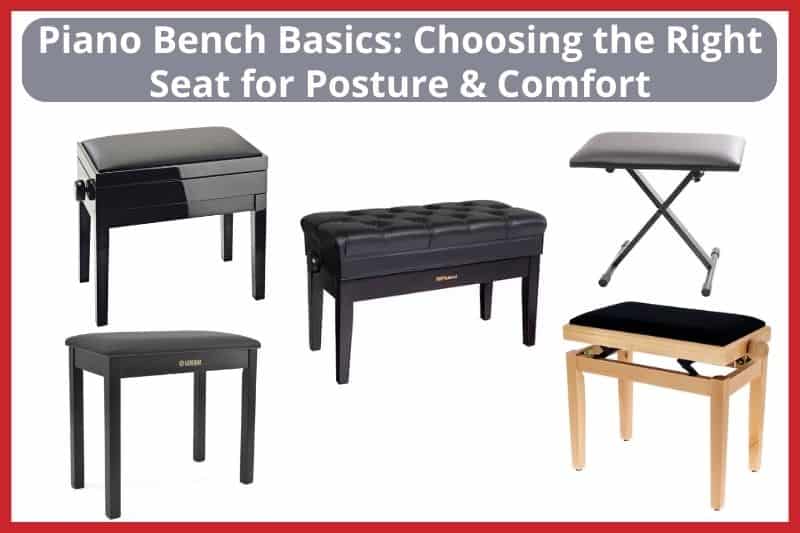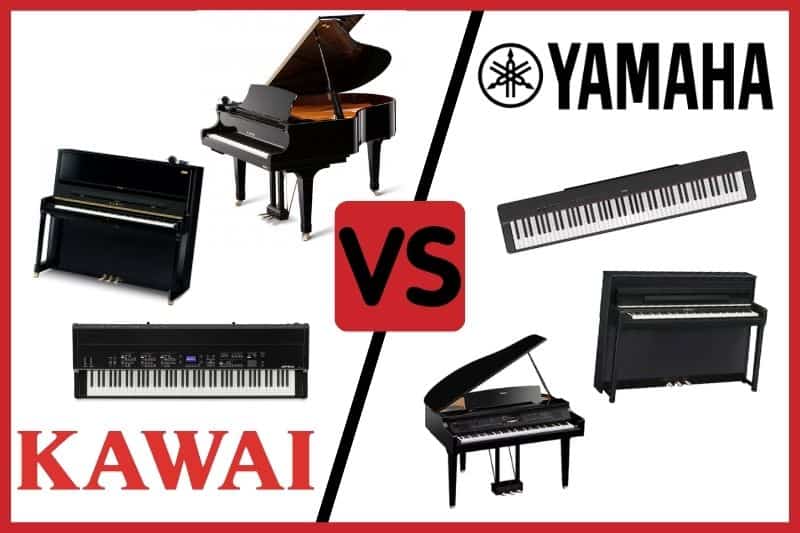When playing the piano, your comfort and technique heavily rely on the type of bench you’re seated on. It’s not just a matter of having a place to sit; the right piano bench can be key to maintaining proper posture and ensuring you’re at the correct height with the keys.
This isn’t just important for professional performers; beginners and hobbyists must also be mindful of their seating to avoid strain and promote effective learning and playing. The bench isn’t just furniture; it’s an extension of your instrument and a tool to enhance your playing experience.

Piano Bench Types
When choosing a piano bench, you’ll encounter various styles, each with unique features that cater to different needs and preferences.
Traditional Bench
Traditional benches are often found with acoustic pianos and have a classic, elegant look. These benches might not offer height adjustment but are known for their sturdiness and commonly feature storage space under the seat. The Yamaha B1 is an example of a traditional bench, typically matching the finish of Yamaha pianos and designed to complement the aesthetic of a grand or upright piano.
Adjustable Bench
Adjustable benches are versatile and ideal for players who value ergonomics, as they allow you to find the perfect height for your playing style. They come in various finishes, such as ebony, and may include additional features like a padded cushion for extra comfort.
Duet Bench
As the name suggests, a duet bench is wide enough for two people, perfect for lessons or four-hand pieces. These are usually fixed-height and provide ample space for both players, embodying a shared musical experience.
Portable Bench
For the musician on the go, portable benches offer lightweight, easy-to-carry solutions. They often fold flat for transport and can be height-adjustable. Although they might not be as robust as traditional or duet benches, they serve well for gigging musicians and those with limited space.
Choosing the Right Size
When selecting a piano bench, getting the right size is crucial for comfort and technique. Here’s how to make sure you find one that fits.
Standard Dimensions
The typical piano bench is 21 to 22 inches in width, designed for solo use. It’s ideal height is typically around 19 inches, which supports a proper posture for playing. The length, sufficient for a single pianist, usually ranges from 30 to 32 inches.
Duet Bench Size
For those seeking a bench to accommodate two players, the duet piano bench is wider, generally measuring about 32 to 33 inches in length. It’s important to ensure that both pianists have enough room without compromising on comfort.
Adjustable Width
Some benches offer adjustable width, allowing you to tailor the space to your needs. This can be particularly useful if you’re teaching students of various sizes or if you enjoy the extra elbow room when you play.
Material and Build Quality
Your piano bench’s materials and construction are crucial for comfort and longevity.
Wooden Benches
Wood is the classic choice for piano benches, known for its strength and aesthetic appeal. Solid wood construction is often seen in high-end benches; beech is a popular choice due to its durability. Some benches offer adjustable heights, making them versatile for players of all sizes.
Padding Materials
Your comfort at the piano can greatly affect your performance. Benches often use foam padding as it provides both support and softness. The thickness and density of the padding can vary, but a medium-firm cushion usually provides a good balance for prolonged playing sessions.
Upholstery
The top layer of the bench, or the upholstery, often comes in a variety of materials, such as imitation or genuine leather. The choice depends on your budget and personal preference. High-quality piano benches will have upholstery that can withstand wear and tear, making them practical options for avid users.
Comfort and Ergonomics
Comfort and ergonomics play a significant role in maintaining proper posture while playing to avoid strain and fatigue.
Correct Posture
Good posture isn’t just about looking poised; it’s about maintaining the correct alignment of your body to prevent injury and play more effectively. The bench you choose should promote correct posture by allowing your feet to rest flat on the floor with your thighs parallel to the ground. Your elbows should be at about the same height as the keys for optimal hand positioning.
Cushion and Support
Your bench should have sufficient padding to support you comfortably during your playing session. Look for benches with padded seats that are arched to conform to your body shape and provide the support your muscles need.
- Cushioning: High-density foam or similar materials that don’t compress too much under your weight
- Support: A seat that maintains its form and doesn’t cause you to sink in after long periods
Adjustability Features
Not all pianists are the same height, nor do they have the same arm or leg length, making adjustability an essential feature.
- Height Adjustment: Allows you to find the most comfortable and ergonomically correct playing position
- Backrest (if available): Offers additional support for those requiring extra spine support
Functional Features
When selecting a piano bench, assessing functional features is essential. You’ll want to consider both the practicality of storage options and the long-term resilience offered by stability and durability.
Storage Options
Many benches come with built-in storage space beneath the seat. This feature allows you to keep your sheet music and accessories neatly tucked away yet easily accessible.
- Piano bench with storage: Ideal for home and studio use where space is at a premium.
- No storage: A slimmer option for those who prioritize portability.
Stability and Durability
A bench’s endurance is defined by its stability and durability.
- Materials: Benches made from hardwood or metal generally offer more sturdiness.
- Construction: Look for a bench with a robust leg design and a secure locking mechanism.
- Weight capacity: Make sure the bench can support your weight without wobbling.
Aesthetics and Style
When choosing a piano bench, considering aesthetics and style is just as vital as ensuring comfort and durability. Your bench should support your posture and complement your instrument and space.
Color Variations
- Black: A versatile choice, blends well with most pianos and interiors.
- White: Ideal match for white or light-colored pianos; may require more frequent cleaning.
- Brown: Offers a traditional look; various shades match well with wooden pianos.
- Walnut, Mahogany, and Cherry: These wood tones provide a classic aesthetic that many find appealing.
You’ll find piano benches in a spectrum from gloss black finish to matte and everything in between. Think about your piano’s finish and your room’s decor when picking the bench’s color.
Finish and Decor
- Gloss Finish: Reflects light for a shiny appearance; often found on black or white benches.
- Satin Finish: A matte alternative with less shine for a subtler look.
- Patterned Fabric: For cushioned benches, patterns can add a personal touch.
Your bench’s finish can range from a high-gloss shine to a gentle satin, each affecting the overall aesthetic. While some benches adopt minimalist styles, others may feature intricate designs that serve as a focal point within the decor of your room.
Specialty Benches for Specific Needs
When selecting a piano bench, it’s crucial to consider your specific situation, whether you’re taking lessons or performing live.
Benches for Piano Lessons
An adjustable bench is essential for new pianists or those engaged in lessons. It allows you to find the most comfortable and ergonomically correct height for playing.
Key Features for Lesson Benches:
- Adjustability: Look for benches that can be raised or lowered to fit your frame.
- Stability: Ensure they’re stable enough to support regular use.
- Comfort: Cushioned benches reduce fatigue during long practice sessions.
Benches for Gigging Musicians
If you’re a gigging musician, your needs will be different. Portability becomes a priority.
Features for Gigging Benches:
- Portability: Lightweight and foldable X-stands are ideal for transportation.
- Durability: Look for benches designed to withstand frequent setup and transport.
- Adjustability: On-the-fly height change capabilities can benefit quick setups at different venues.
Frequently Asked Questions
Selecting the right piano bench height and adjusting it for various players are key for comfort and playability.
What is the ideal height for a piano bench when considering proper ergonomics?
Your piano bench height is crucial for maintaining good posture and preventing injury. Ideally, when seated at the piano, your forearms should be parallel to the floor with your wrists straight. This position allows for free movement of your arms and fingers across the keyboard. A bench height that leaves your elbows at just about the same level as the keys usually meets these ergonomic needs.
How can I adjust the height of a piano bench for a child?
For children, a standard piano bench may be too high. If the bench isn’t adjustable, use a sturdy cushion or a specifically designed booster to raise the child’s seating position. For adjustable benches, lower the seat until the child’s feet can rest flat on the floor or on a footstool, with their forearms parallel to the keyboard. Remember to check and readjust the height as the child grows.



